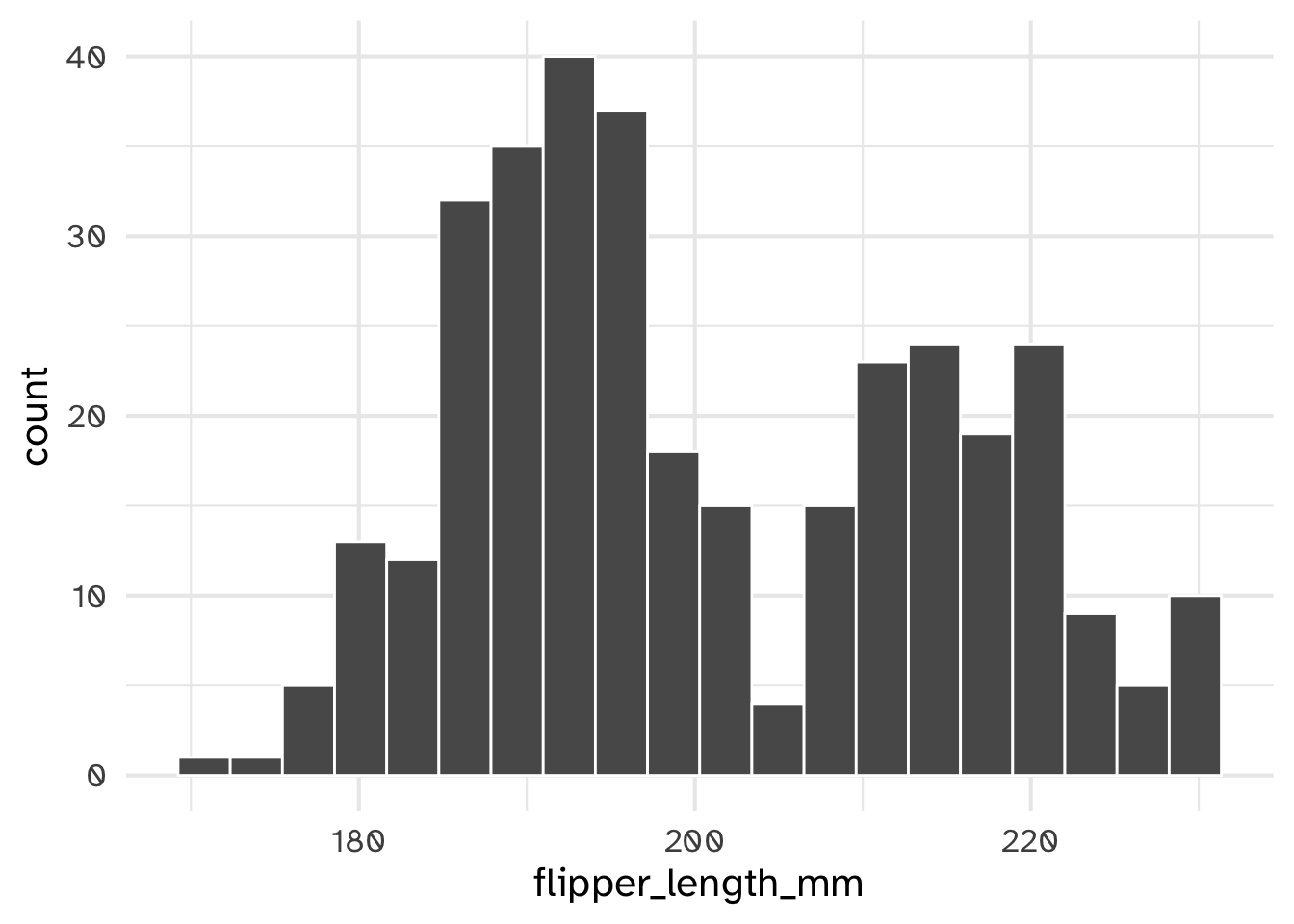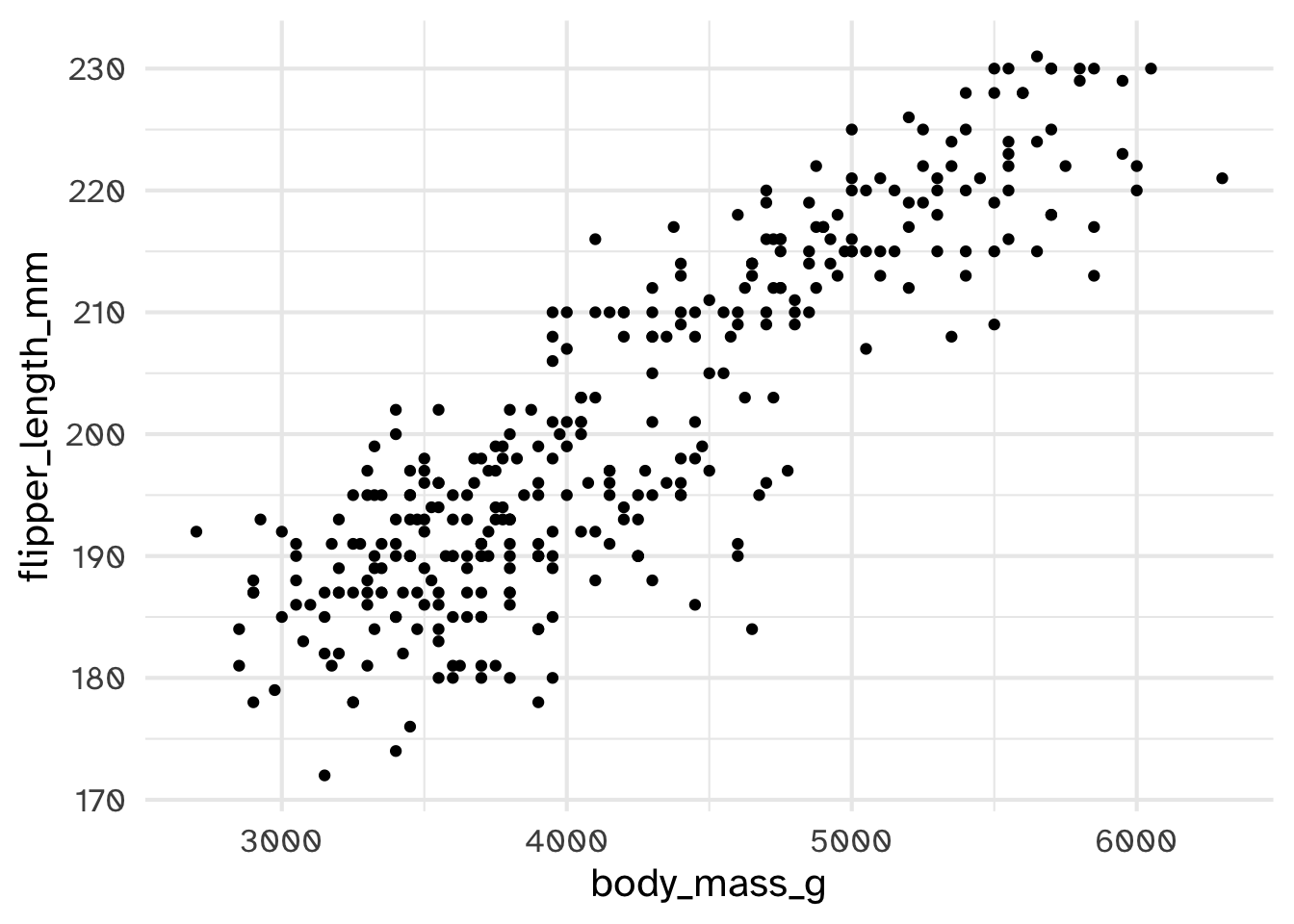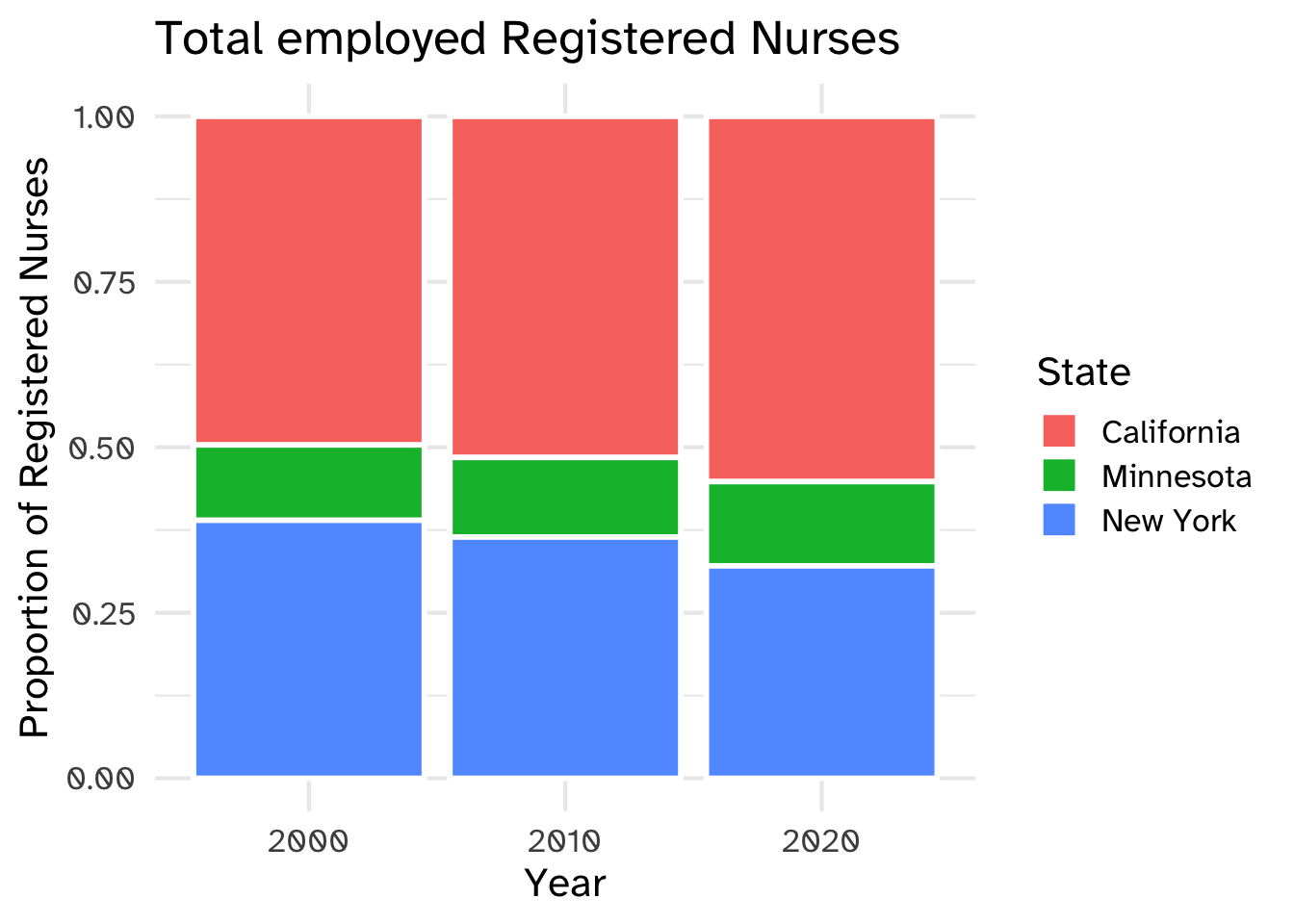library(palmerpenguins)
ggplot(penguins) +
geom_histogram(bins = 20, col = "white", aes(x = body_mass_g))


Day 06
Carleton College
Stat 220 - Spring 2025
Each plot shares aesthetics but shows different subsets of data
The plots might share data, but don’t share aesthetics

p1 <- ggplot(penguins) +
geom_histogram(bins = 20, col = "white", aes(x = body_mass_g, fill = species))
p2 <- ggplot(penguins) +
geom_histogram(bins = 20, col = "white", aes(x = flipper_length_mm, fill = species))
p3 <- ggplot(penguins) +
geom_point(shape = 21, alpha = .9, col = "white", aes(x = body_mass_g, y = flipper_length_mm, fill = species))
p3 + (p1/p2) 
p1 <- ggplot(penguins) +
geom_histogram(bins = 20, col = "white", aes(x = body_mass_g, fill = species))
p2 <- ggplot(penguins) +
geom_histogram(bins = 20, col = "white", aes(x = flipper_length_mm, fill = species))
p3 <- ggplot(penguins) +
geom_point(shape = 21, alpha = .9, col = "white", aes(x = body_mass_g, y = flipper_length_mm, fill = species))
p3 + (p1/p2) +
plot_layout(guides = 'collect')
point legend)p1 <- ggplot(penguins) +
geom_histogram(bins = 20, col = "white", aes(x = body_mass_g, fill = species))
p2 <- ggplot(penguins) +
geom_histogram(bins = 20, col = "white", aes(x = flipper_length_mm, fill = species))
p3 <- ggplot(penguins) +
geom_point(shape = 21, alpha = .9, col = "white", aes(x = body_mass_g, y = flipper_length_mm, fill = species)) +
theme(legend.position = "none")
p3 + (p1/p2) +
plot_layout(guides = 'collect')
Categorical variables
Order doesn’t matter

Numeric variables
Order matters

Diverging variables
Midpoint matters

Use colorblind friendly color scales (e.g., Okabe Ito, viridis)

Use shape and color where possible
Default ggplot2 scale

Default ggplot2 scale with deuteranopia

Prefer direct labeling where color is used to display information over a legend
Quicker to read
Ensures graph can be understood without reliance on color
Default ggplot2 scale

Default ggplot2 scale with deuteranopia

Default ggplot2 scale

Default ggplot2 scale with deuteranopia

Separate elements with whitespace or pattern
Allows for distinguishing between data without entirely relying on contrast between colors
Default ggplot2 scale

Default ggplot2 scale with tritanopia

Default ggplot2 scale

Default ggplot2 scale with tritanopia

It is read by screen readers in place of images allowing the content and function of the image to be accessible to those with visual or certain cognitive disabilities.
It is displayed in place of the image in browsers if the image file is not loaded or when the user has chosen not to view images.
It provides a semantic meaning and description to images which can be read by search engines or be used to later determine the content of the image from page context alone.
CHART TYPE of TYPE OF DATA where REASON FOR INCLUDING CHART
(plus link to data source somewhere in the text)
CHART TYPE of TYPE OF DATA where REASON FOR INCLUDING CHART

01:30
Accessible Visualization via Natural Language Descriptions: A Four-Level Model of Semantic Content
Alan Lundgard, MIT CSAIL
Arvind Satyanarayan, MIT CSAIL
IEEE Transactions on Visualization & Computer Graphics (Proceedings of IEEE VIS), 2021
To demonstrate how our model can be applied to evaluate the effectiveness of visualization descriptions, we conduct a mixed-methods evaluation with 30 blind and 90 sighted readers, and find that these reader groups differ significantly on which semantic content they rank as most useful. Together, our model and findings suggest that access to meaningful information is strongly reader-specific, and that research in automatic visualization captioning should orient toward descriptions that more richly communicate overall trends and statistics, sensitive to reader preferences.
CHART TYPE of TYPE OF DATA where REASON FOR INCLUDING CHART
Take one graph and two blank cards
Write an alt text description of your graph on one of your blank cards.
In two’s or three’s, trade alt text descriptions only
On your second blank card, try to draw the graph based on the alt text provided.
Now, look at the original graph. How’d you do?
04:00
Short:
nurses_subset |>
ggplot(aes(x = year, y = hourly_wage_median, color = state)) +
geom_point(size = 2) +
ggthemes::scale_color_colorblind() +
scale_y_continuous(labels = scales::label_dollar()) +
labs(
x = "Year", y = "Median hourly wage", color = "State",
title = "Median hourly wage of Registered Nurses"
) +
theme(
legend.position = c(0.15, 0.75),
legend.background = element_rect(fill = "white", color = "white")
)
Use both color and shape aesthetics
nurses_subset |>
ggplot(aes(x = year, y = hourly_wage_median, color = state, shape = state)) +
geom_point(size = 2) +
scale_y_continuous(labels = scales::label_dollar()) +
labs(
x = "Year", y = "Median hourly wage", color = "State", shape = "State",
title = "Median hourly wage of Registered Nurses"
) +
theme(
legend.position = c(0.15, 0.75),
legend.background = element_rect(fill = "white", color = "white")
)
Could do “by hand” with annotate(). Alternatively, use geom_text()
nurses_subset |>
ggplot(aes(x = year, y = annual_salary_median, color = state)) +
geom_line(show.legend = FALSE, linewidth = 2) +
geom_text(
data = nurses_subset |> filter(year == max(year)),
aes(label = state), hjust = 0, nudge_x = 1,
show.legend = FALSE, size = 6
) +
scale_y_continuous(labels = scales::label_dollar(scale = 1/1000, suffix = "K")) +
labs(
x = "Year", y = "Annual median salary", color = "State",
title = "Annual median salary of Registered Nurses"
) +
coord_cartesian(clip = "off") +
theme(
plot.margin = margin(0.1, 0.9, 0.1, 0.1, "in")
)
First, filter the data to include the endpoints only. Use the label aesthetic to map to the label in your data (in this case, state). geom_label by default will use the x and y aesthetics defined in ggplot()
nurses_subset |>
ggplot(aes(x = year, y = annual_salary_median, color = state)) +
geom_line(show.legend = FALSE, linewidth = 2) +
geom_text(
data = nurses_subset |> filter(year == max(year)),
aes(label = state)
) +
scale_y_continuous(labels = scales::label_dollar(scale = 1/1000, suffix = "K")) +
labs(
x = "Year", y = "Annual median salary", color = "State",
title = "Annual median salary of Registered Nurses"
) +
coord_cartesian(clip = "off") +
theme(
plot.margin = margin(0.1, 0.9, 0.1, 0.1, "in")
)
(Here’s what it looks like if we don’t filter to the endpoints)
nurses_subset |>
ggplot(aes(x = year, y = annual_salary_median, color = state)) +
geom_line(show.legend = FALSE, linewidth = 2) +
geom_text(
aes(label = state)
) +
scale_y_continuous(labels = scales::label_dollar(scale = 1/1000, suffix = "K")) +
labs(
x = "Year", y = "Annual median salary", color = "State",
title = "Annual median salary of Registered Nurses"
) +
coord_cartesian(clip = "off") +
theme(
plot.margin = margin(0.1, 0.9, 0.1, 0.1, "in")
)
hjust=0 means “left justified”, or make the label start at the x-y coordinate you gave it. size = 6 makes the label bigger
nurses_subset |>
ggplot(aes(x = year, y = annual_salary_median, color = state)) +
geom_line(show.legend = FALSE, linewidth = 2) +
geom_text(
data = nurses_subset |> filter(year == max(year)),
aes(label = state),
hjust = 0,
size = 6
) +
scale_y_continuous(labels = scales::label_dollar(scale = 1/1000, suffix = "K")) +
labs(
x = "Year", y = "Annual median salary", color = "State",
title = "Annual median salary of Registered Nurses"
) +
coord_cartesian(clip = "off") +
theme(
plot.margin = margin(0.1, 0.9, 0.1, 0.1, "in")
)
nudge_x = 1 “nudges” each label one unit in the x-direction (so each label is a small distance away from what it’s labeling). show.legend=FALSE tells ggplot not to include the aesthetics for geom_text in the legend
nurses_subset |>
ggplot(aes(x = year, y = annual_salary_median, color = state)) +
geom_line(show.legend = FALSE, linewidth = 2) +
geom_text(
data = nurses_subset |> filter(year == max(year)),
aes(label = state),
hjust = 0,
size = 6,
nudge_x = 1,
show.legend = FALSE,
) +
scale_y_continuous(labels = scales::label_dollar(scale = 1/1000, suffix = "K")) +
labs(
x = "Year", y = "Annual median salary", color = "State",
title = "Annual median salary of Registered Nurses"
) +
coord_cartesian(clip = "off") +
theme(
plot.margin = margin(0.1, 0.9, 0.1, 0.1, "in")
)
Finally, we have to tell ggplot not to trim the plot, and leave room in the right margin for the labels themselves
nurses_subset |>
ggplot(aes(x = year, y = annual_salary_median, color = state)) +
geom_line(show.legend = FALSE, linewidth = 2) +
geom_text(
data = nurses_subset |> filter(year == max(year)),
aes(label = state),
hjust = 0,
size = 6,
nudge_x = 1,
show.legend = FALSE,
) +
scale_y_continuous(labels = scales::label_dollar(scale = 1/1000, suffix = "K")) +
labs(
x = "Year", y = "Annual median salary", color = "State",
title = "Annual median salary of Registered Nurses"
) +
coord_cartesian(clip = "off") +
theme(
plot.margin = margin(0.1, 0.9, 0.1, 0.1, "in")
)
Set the color aesthetic to white
nurses_subset |>
filter(year %in% c(2000, 2010, 2020)) |>
ggplot(aes(x = factor(year), y = total_employed_rn, fill = state)) +
geom_col(position = "fill", color = "white", linewidth = 1) +
labs(
x = "Year", y = "Proportion of Registered Nurses", fill = "State",
title = "Total employed Registered Nurses"
)